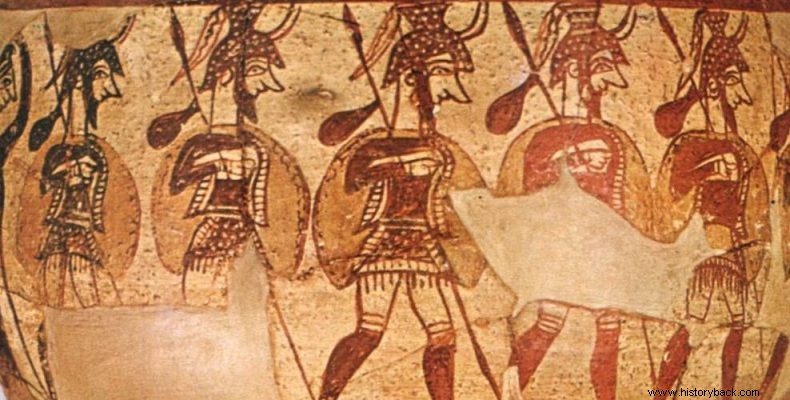
It is considered, wrongly, that the type of hoplite warrior, which dominated the battlefields of the classical times, was a consequence of the creation of the institution of the city-state. In fact, the Late Mycenaean heavy infantry also fought as hoplites.
Until the Trojan War (mid 13th century BC) the basic type of infantry of the Mycenaean armies was the soldier equipped with an octagonal or foot shield and a long spear (thick, length over 3m), who fought in a deep formation , phalanx type. This type of infantry continued to be in service – based on the Iliad – in the Trojans as well.
The states of Pylos, Crete and Salamis are said to have preserved the old way of fighting even on the Trojan plain. The other Mycenaean states, however, changed their battle tactics, except for some which from the beginning followed a more flexible battle tactic. The reason for the change in the infantry's armament and way of fighting clearly has to do with the changes that took place in the armament and tactics of using tanks, but also in the new broader view of war as such.
The Achaean heavy infantry of the period now approached the model of the hoplite of classical times, fighting in a manner similar to that of the "Ekdromus" hoplites of the classical period. The long lance was replaced by a shorter and lighter spear, capable of being used as a javelin, and the long swords of the first period gave way to shorter straight swords with an average blade length of 60 cm (longer and shorter examples exist) .
He probably had additional javelins, like the early hoplites of the Geometric period, which he threw before contact with the opponent, fighting afterwards with spear and sword.
The Achaean hoplite of the period could now fight on any type of terrain, either in a dense phalanx formation or in a looser order, "peltastically", depending on the opponent and the terrain, just as the Expeditionary hoplites of the late 5th and 4th centuries fought . e.g. and the Pesetairs and the Supporters of M. Alexander.
In addition to the incisors, the octagonal and foot shields were replaced by smaller, round or slightly elliptical ones, such as those depicted on the famous warrior vase, early Boeotian models of hoplite shields.
Exactly this type of warrior is mainly described by Homer in the Iliad as sharpening, fighting with swords, striking with his spear. The battles in this period were much more "fluid" and had the character of a set of individual conflicts more. Men thickened their yokes only when they were about to receive an advance of enemy chariots.
In the rear yokes, archers could once again take their place, who supported the formation with overhead shots. On the contrary, when they were fighting against infantry, especially if it had mounted weapons, the Achaean hoplites "opened" their yokes, in order to limit losses from enemy projectiles and approached the enemy at speed.
The men of the first yokes, called "Promachoi" (the first in battle), almost always wore a breastplate-similar to the bell shape of the geometric times. And their shields also had a handle and could be used offensively.
The Achaean hoplites were supported – like the peltasts later – by detachments from specific geographical areas who fought "peltastically". They were mainly detachments of men from mountainous regions of Greece, which traditionally produced excellent light infantry.
Such sections belonged to the Locrians, the Phocians, the Aitolians, but also the Epirotians and the Pylians, as evidenced by the frescoes of the so-called Nestorian palace in Pylos. Pylian light infantry are depicted with helmet, short spear-javelin and sword putting to flight Oresivian barbarians.
An exception was the famous Myrmidons of Achilles. The Myrmidons were also armed, with a round shield, spear, javelin and sword. Helmets and breastplates were definitely worn by the Promahos. The Myrmidons were an elite unit, not because they carried innovative weapons for the time, but because of the offensive tactics they used. They fought like other Achaean hoplites, but took the opponent by surprise with their momentum, relying on a quick, dashing attack to break up opponents.
If the latter did not have the necessary training, cohesion and composure, it was certain that they would be swept away by the raid of the Myrmidons. In the Iliad, it is easy to see how much the Trojans valued and feared the Myrmidons and their leader, Achilles, despite the fact that the elite Myrmidons were few - 2,500 men, according to the Iliad.
The Achaean hoplite of the time was the direct ancestor of the hoplite equipped with spear and javelin of the Geometric times and the "great-grandfather" of the hoplites who wrote pages of glory in the 5th and 4th centuries. BC
